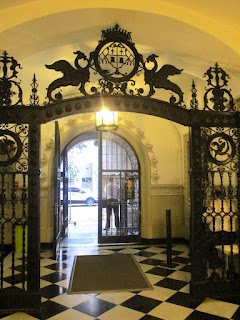Almost a Must-See for every visitor to Buenos Aires, Argentina, is the Evita Museum. It is run by the Evita Peron Organization to remind visitors to her impressive legacy. Not only as the First Lady and as a supporter of labor rights. She also ran the Ministries of Labor and Health, founded and ran the charitable Eva Peron Foundation, championed for women’s rights in Argentina, and founded and ran the nation's first large-scale female political party, the Female Peronist Party.
Before her early cancer death, she took an unprecedented role as a powerful creator of a foundation to help workers and the poor. She was called the “Spiritual Leader of the Nation" by the Argentine Congress. As much as Evita was loved, she was equally hated by many of the country’s wealthy and powerful who were wary of her growing popularity and influence.
Seven decades after her early cancer death in 1952, and the State Funeral in Buenos Aires at the Recoleta Cemetary, Evita continues to awaken passions in Argentina as her followers believe her image as a champion of the poor is more relevant than ever at a time when inequality and poverty are rising as the economy remains stagnated amid galloping inflation. Evita has been the subject of countless books, movies, TV shows, and even a Broadway musical. Still, for some of her oldest, most ardent followers the connection with the actress-turned-political leader is much more personal.
The Evita Peron Organization describes her:
The children in the Society’s orphanages, heads shaven, identified by numbers, not by names, stood on the street corners holding tin bowls or stiff signs - “Collection for Poor Children.” Evita knew what it was to be without work and poor, and after she visited postwar Europe in 1947 she learned what to do and what not to do for those who needed help.
Her towns, schools, hospitals, villages for seniors, and homes for working women and their children were designed with the concept of helping and respecting people as individuals rather than efficiently accommodating numbers. In the Children’s City, uniforms were banished - but clothes and toys came from the best shops in Buenos Aires. If you look at the children in the residences built by Evita’s Foundation throughout the country you will see that each child is dressed differently.
Part of Evita’s legacy was accomplished in partnership with Perón and Congress. Together they forged a safety net for the children, the workers, the seniors, and the poor of Argentina. Each group had a Decalogue of Rights. The Rights of Seniors were assisted to a dwelling place, to food, to clothing, to health care, to spiritual care, to entertainment, to work, to tranquility and to respect.
The workers’ safety net included access to health care, minimum wage, paid vacations, and pensions. Also, Evita was instrumental in obtaining the vote for women. In 1951, women were elected to Congress for the first time. And they were all Peronistas. Only the Partido Peronista Feminino had presented a list of women candidates for Congress.
...Many of the things she made available - pots and pans, beds, houses, sewing machines, footballs - had meaning and usefulness because Evita was aware of exactly what difference it made to the life of a poor family to have these things. The work of the Foundation was efficient and personal, far more so than it might have been had it been bureaucratically exercised."
Evita’s Foundation constructed twelve hospitals throughout the country. The Polyclinic President Perón in the working class neighborhood of Avellaneda was a teaching hospital. It sent out a Tren Sanitario in 1951. The train went throughout Argentina providing free inoculations, x-rays, and medicines.
Evita established a School of Nursing. Just as she worked to get women the vote and a place in Congress so she worked with the head of the School of Nursing, Teresa Adelina Fiora, to create a new kind of nurse - one who could drive a jeep, set up and run a clinic in the interior of the country where doctors were scarce, go overseas on humanitarian missions, take initiative.
Her Homes for Seniors were really “ villages,” complete with workshops so that those who wanted to continue working at a useful occupation (from carpentry to milking cows) could do so. Evita believed that seniors should live in a place that encouraged them to go on living, not just wait for death.
Her Children’s Homes, the Hogar-Escuelas or Home-Schools, were also a place to live securely and to grow, a place where you were called by your name, never by a number, and never a place where you would have your head shaved as punishment because you were poor.
Continue reading all she had done for her country and the whole biography
https://www.evitaperon.org/part1.htm
.
Evita Museum
Tuesday - Sunday 11:00 - 19:00 Admission 4,700 pesos ca. $5
Calle Lafinur 2988, Intersection Juan Marìa Gutièrrez
https://www.evitaperon.org/eva_peron_museum.htm
========
.






No comments:
Post a Comment
Note: Only a member of this blog may post a comment.